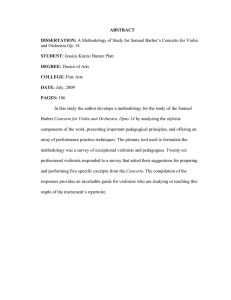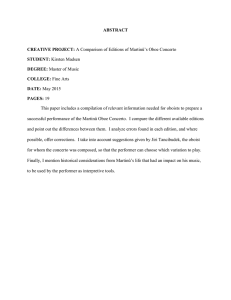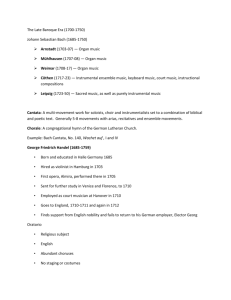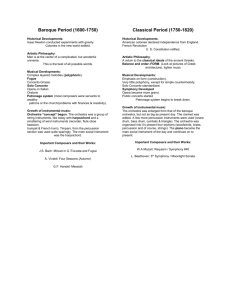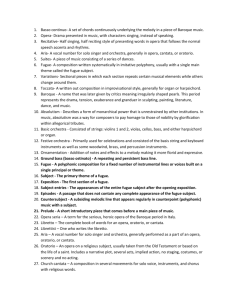The concerto through time - Topic exploration pack (DOC, 647KB) 25/02/2016
advertisement
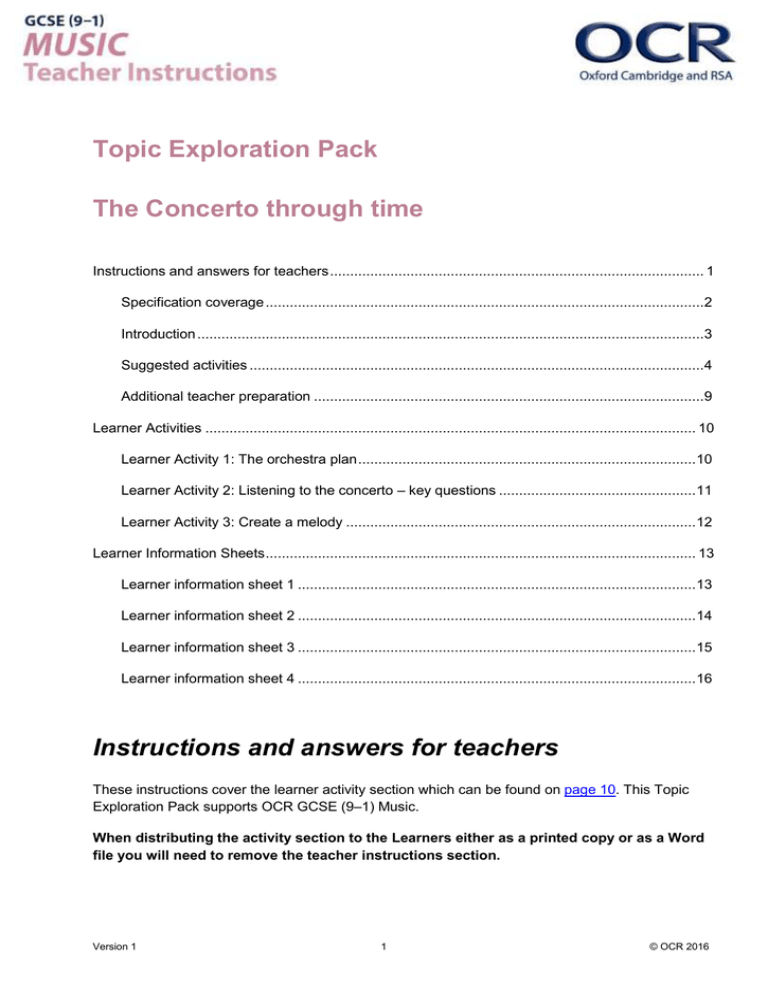
Topic Exploration Pack The Concerto through time Instructions and answers for teachers ............................................................................................. 1 Specification coverage .............................................................................................................2 Introduction ..............................................................................................................................3 Suggested activities .................................................................................................................4 Additional teacher preparation .................................................................................................9 Learner Activities .......................................................................................................................... 10 Learner Activity 1: The orchestra plan .................................................................................... 10 Learner Activity 2: Listening to the concerto – key questions ................................................. 11 Learner Activity 3: Create a melody ....................................................................................... 12 Learner Information Sheets ........................................................................................................... 13 Learner information sheet 1 ................................................................................................... 13 Learner information sheet 2 ................................................................................................... 14 Learner information sheet 3 ................................................................................................... 15 Learner information sheet 4 ................................................................................................... 16 Instructions and answers for teachers These instructions cover the learner activity section which can be found on page 10. This Topic Exploration Pack supports OCR GCSE (9–1) Music. When distributing the activity section to the Learners either as a printed copy or as a Word file you will need to remove the teacher instructions section. Version 1 1 © OCR 2016 Specification coverage There are four styles of concerto to study and they are taken from three history periods: ● ● ● ● The Baroque Solo Concerto. The Baroque Concerto Grosso. The Classical Concerto. The Romantic Concerto. Learners need to study these styles in order to develop: ● ● ● ● ● ● Version 1 an understanding of what a concerto actually is how the solo instrument(s) work with the accompanying orchestra how music develops over time in terms of instruments and the orchestra the changing complexity of the music the ability to distinguish between the music of the three different periods by studying the characteristics of each on an underlying knowledge of a variety of musical elements and to look at how these elements are used within the music – a key aspect to this area of study. 2 © OCR 2016 Introduction The Concerto is an important genre within Western Classical Music. It is an excellent way to trace the development of Western music across time with an opportunity to listen to and explore many wonderful pieces of music played by some astonishing musicians. Four information sheets for learners have been provided as the final section of this pack which give an overview for each of the four types of concerto to be studied. These provide a quick overview of the main features found within each concerto style and era and are hopefully a good resource to use to help support the teaching of the basic features. One of the key features within this area of study is to trace the development of the concerto and for learners to be able to recognise the changes that occur over time. These changes are varied and it is important that teachers choose music that is clearly within each period and does not in any way confuse the history periods. Learners may well have listened to concertos during their key stage three music lessons. However, no doubt learners will have experienced a wide range of different styles of music due to their own preferences or cultural background. This does not matter at all; the level of knowledge will be quite general and the skills taught should primarily focus on the learners’ listening. Learners often find it difficult to explain in words what they hear in the music. This is a skill that needs to be nurtured and started early on in the course. Much of the work undertaken for Area of Study 2 will focus on the listening and appraising paper, so it is these skills that need to be taught. However, there are opportunities to use this area of study as a starting point for composition or exploring the genres through performing tasks. For assessment in the Practical Portfolio, there will always be a brief linked to Area of Study 2 and learners may use this and then go on to choose a stimulus from which to start their piece. The sample composition brief for this area of study is as follows: Create a melodic solo and accompaniment composition, suitable for presentation at a Performing Arts Showcase evening. There are obviously some stimuli that are better suited to this type of composition than others. Either of the note patterns or the rhythmic phrases will work very well (the 7/8 one will perhaps present a challenge to a gifted musician). The chords would also be an appropriate stimulus. The story, image and words do not really lend themselves to this task and learners should be guided throughout the course towards being able to choose a suitable stimulus. Version 1 3 © OCR 2016 Suggested activities Starters and Plenaries Many learners find the identification of orchestral instruments quite difficult. They often muddle wind instruments up and confuse instruments such as the oboe, clarinet, trumpet and horn. They also find some of the orchestral percussion instruments difficult to distinguish. There are a number of activities that can support this: ● ● ● Preselect a number of pieces that have an instrumental solo (these do not all have to be from concertos - they can be sonatas, symphonies, string quartets etc.- all musical experience is good) and put them into a playlist in YouTube or Spotify for example. There is a list of some possible pieces below. Create a worksheet with pictures of instruments or just use a blank piece of paper for learners to write their answers on and play several pieces from which they can try to identify the instruments. This activity can be done right at the beginning of the course. The above activity can also be done using the musical history periods and various pieces from the Baroque, Classical and Romantic periods can be played. Learners could be given a set of three cards to hold up to show which period they think it comes from. This might be an activity that is done a little later in the course when they have done some work on the features of each period. It might be better to use concertos for this but it is not essential. If you have accomplished musicians in your class, of any style, ask them to play a challenging piece or passage from a piece which the other learners can listen to. This could be from some Classical repertoire or it could be an improvisation from a jazz or rock piece. This could lead well into a discussion on the virtuosic nature of the concerto and in particular the cadenza and also help learners to hear the musical features in a solo line. Some pieces that might be used for instrument identification: ● Sheherazade – Rimsky-Korsakov – violin and harp. ● Gabriel’s oboe. ● Tchaikovsky 5th Symphony 2nd movement – French Horn. ● Saint-Saens' Carnival of the Animals – various. ● Mozart Clarinet Concerto – 2nd movement. ● Hummel Trumpet Concerto. ● Le Tombeau de Couperin – Ravel – oboe. ● Prelude a l’apres-midi d’un faun – Debussy – flute. ● Fanfare for the Common Man – Brass and timpani ● The Young Person’s Guide to the Orchestra is of course a wonderful piece of music and gives an overview of nearly all of the instruments that they need to recognise. Playing this can often provide a useful cover lesson along with some picture identification worksheets. ● There are many websites that have good information and examples of what instruments sound like and learners can be encouraged to use these to support their study or you can use some of them in your lessons. Here are two sites that you might like to visit: http://www.philharmonia.co.uk/explore/instruments http://www.english-online.at/music/orchestra/orchestra.htm Version 1 4 © OCR 2016 Main lesson activities As this is perhaps the most traditional of the areas of study, the teaching approach to it may be more formal than it might be with the other areas of study. Choose some wonderful and exciting concertos which will hopefully engage and excite your learners. Taking learners to a live concert where a concerto is being performed is a great thing to do - there are performances of concertos on YouTube and watching some or parts of some of these can be just as good. Here are a few: ● ● ● ● Rachmaninov 2nd Piano concerto 4th movement – there are some lovely close ups of the orchestra and the soloist. https://www.youtube.com/watch?v=f3c8Vj87JDc Tchaikovsky piano concerto – with Karajan and Evgeny Kissin. https://www.youtube.com/watch?v=kzoPBj5NKRg Bach Brandenburg Concerto No 2 - https://www.youtube.com/watch?v=3HSRIDtwsfM Anne Sophie Mutter – Mozart violin concerto No 5 – she conducts as well as plays the solo. https://www.youtube.com/watch?v=ETXPKHPPov8 Within this study the development of the orchestra is important - how different instruments were introduced and how some, e.g. the harpsichord, were discarded. Also consider how the orchestra grew over time from something quite small and intimate to something large and dramatic. Of course a great deal of information regarding this looks at the orchestra alone, however it is relevant to study the orchestra and then extend the study to include the use of the soloist. Some possible lesson activities have been included below. Version 1 5 © OCR 2016 Learner activity 1: The Orchestra plan A sheet with sets of shapes relating to the plan of the orchestra and how it might change over time has been included (see Learner activity 1 worksheet). Have some fun with the shapes and instruments with learners developing their understanding of how an orchestra grows over time. Here are some examples: ● ● ● ● ● The shapes can be printed and then cut out for learners to stick onto paper to give real perspective of how the orchestra changes. (It might be better to enlarge to A3.) The shapes could be laminated and learners could place them on paper in the relevant places. You could make them much larger and possibly attach magnets to use them on a large board as a more interactive game. It might also be possible to use these with computers and manipulate the shapes into the development of orchestral plans. You could play an excerpt from a concerto and while they are listening learners could be working with the shapes as they hear the various orchestral instruments and sections. To work alongside this type of activity there are many excellent plans of the orchestra on the web that your learners could explore – such as the one below. Find other images, including Baroque and the modern day plan here: https://sites.google.com/site/retromusics/evolutionoforchestra Version 1 6 © OCR 2016 Learner activity 2: Listening to the concerto – key questions As listening is the main focus for this topic, the early introduction of listening activities would be beneficial. The starter activities can help to reinforce the recognition of instruments but there must be significant work done on how the instruments work together and how that changes over time. A possible listening activity for the concerto might be as follows (a set of questions is given below to help with this activity – see Learner Activity 2.) i Listen to the entry of the oboe in the 1st movement of the C major Concerto by Mozart for 16 bars. (The opening of many Classical concertos is just for the orchestra alone so it is usually more appropriate to start from where the soloist enters.) ii Discuss the general features of the music: ● Fast, major, 4/4 etc. iii Discuss the features played by the solo instrument – this will help learners to understand musical terminology and to begin to recognise what constitutes appropriate features: (this might be quite basic at first but as the learners develop more understanding as the course progresses then more and more detail should be observed): ● ● ● Trill (major), scale, very long note maybe with a crescendo For able candidates the recognition of a potential modulation to the dominant and back may be possible The melody then uses fast notes (quavers and semiquavers), that move mostly in step with a mixture of staccato and legato and then a trill before ending on the tonic. iv Discuss the features of the music played by the orchestra and how it supports the soloist: ● ● ● ● ● Only strings repeated notes in the bass line simple harmony while the oboe plays the long note the violins play a melody when the oboe is moving the strings play simple repeating chords. This idea may be used with a range of different concertos: i Listen to the opening of Tchaikovsky’s 1st Piano Concerto and ask a variety of questions about the opening. Before the main melody starts there is a: ● Horn melody – fanfare like – alternating with orchestral chords three times and then chords to follow – very dramatic. Texture and tonality can also be discussed. ii The main melody follows: ● This is played by the violins with a chordal accompaniment from the solo piano, which is perhaps unexpected because often the solo instrument will have the melody while the orchestra has the chordal accompaniment. These features can be discussed but the level of detail may vary depending how much listening of this nature has already been completed. Version 1 7 © OCR 2016 Learner activity 3: Create a melody This topic is a very good medium for learning the basic features of the composition and for learning how to construct a good melody with an appropriate accompaniment. Listen to the 2nd movement of Mozart’s Clarinet Concerto and discuss features of the melody as you might have done above – a copy of part of the melody can be found below. (You could repeat this exercise with any number of melodies from Classical concertos in particular.) The melody: ● ● ● ● ● ● ● ● ● Version 1 has two eight bar phrases and these are made up from balanced two bar phrases is based on tonic and dominant harmony has use of arpeggiaic and scalic ideas has sequences from bars 9 to 14 contains varied and interesting rhythm. The accompaniment is: rocking repeating chords mostly simple harmony – chords I, IV and V simple bass line with many root position chords. 8 © OCR 2016 The accompaniment is: ● ● ● rocking repeating chords mostly simple harmony – chords I, IV and V simple bass line with many root position chords. For a practical, performance and composition activity, learners could now be encouraged to create their own melody and accompaniment. This can be completed in a straightforward way with which the majority of learners can progress but it can also be used by more able learners to create more complex melodic lines and harmonic progressions. The learners could be given stimuli similar to those on the sample brief for the Practical Component, i.e. a two bar rhythm, a seven note pattern or a set of four chords, or they could compose freely as they might for the Integrated Portfolio. The Mozart Clarinet Concerto is used for a question on the SAM listening paper so a link can be made here between two areas of the course. Compartmentalisation is often a problem for learners. They do not appreciate how performance, composition and listening all interlink and skills learnt can and should be transferred. Additional teacher preparation There is a specimen paper for this specification and there are two questions for this area of study on that paper – one notation question and one comparison question. There are also two questions that already exist from the legacy specification from the shared music genre of the Classical Concerto: ● June 2010 – question 4 – notation ● June 2012 – question 4 – notation. We’d like to know your view on the resources we produce. By clicking on ‘Like’ or ‘Dislike’ you can help us to ensure that our resources work for you. When the email template pops up please add additional comments if you wish and then just click ‘Send’. Thank you. If you do not currently offer this OCR qualification but would like to do so, please complete the Expression of Interest Form which can be found here: www.ocr.org.uk/expression-of-interest OCR Resources: the small print OCR’s resources are provided to support the teaching of OCR specifications, but in no way constitute an endorsed teaching method that is required by the Board, and the decision to use them lies with the individual teacher. Whilst every effort is made to ensure the accuracy of the content, OCR cannot be held responsible for any errors or omissions within these resources. © OCR 2016 - This resource may be freely copied and distributed, as long as the OCR logo and this message remain intact and OCR is acknowledged as the originator of this work. OCR acknowledges the use of the following content: Orchestra layout diagram: elenabsl/Shutterstock.com, Bach: Historical/Shutterstock.com, Recorder: Bernice Williams/Shutterstock.com, Orchetstra: IgorGolovniov/Shutterstock.com, Cellist: Brian A Jackson/Shutterstock.com Please get in touch if you want to discuss the accessibility of resources we offer to support delivery of our qualifications: resources.feedback@ocr.org.uk Version 1 9 © OCR 2016 Conductor Learner Activities Conductor Learner Activity 1: The orchestra plan D Basses Cellos D Bass Violas Violas 2nd Violin Cellos Tuba D. Bassoon Oboe Bass oon Flutes Oboes Bassoons Clarinets Horn Cor Anglais Picco lo Flute Flutes Oboes Bassoons Clarinets Trum pet Trumpets Horns Trombones Trumpets Horns Timpani Triangle Bass Drum Xylophone Glockenspiel Timpani Bass Drum Snare Drum Castanets Cymbal Timpani Version 1 2nd Violins 1st Violins 10 Cellos Harpsichord 1st Violin Violas 1st Violins 2nd Violins © OCR 2016 Learner Activity 2: Listening to the concerto – key questions 1. Listen to the entry of the oboe in the 1st movement of the C major Concerto by Mozart for 16 bars: a) How many beats are there in a bar? [1] b) Suggest a tempo for this music. [1] c) What is the tonality of this extract? [1] 2. Tick the box next to the statement that correctly describes the first entry of the oboe. It plays an arpeggio. It plays a minor scale. [1] It plays repeated notes. It plays a major scale. 3. Underline the word that best describes the dynamic for the long note played by the oboe near the beginning. Diminuendo Rallentando Crescendo Pianissimo [1] 4. Describe features of the accompaniment while the long note is being played. [3] 5. From which history period does this music come? [1] 6. Give two reasons for your answer. [2] Total [11] Version 1 11 © OCR 2016 Learner Activity 3: Create a melody Using one of the stimuli from the Sample Composition Briefs (downloadable from the OCR website: http://www.ocr.org.uk/Images/219377-unit-j536-03-and-j536-04-practical-componentcomposition-brief.pdf), create a melody, create a melody and an accompaniment for a solo instrument accompanied by either a piano, guitar or a small group of instruments. Create a melody that: ● ● ● ● ● has two eight bar phrases using balanced two bar phrases is based on tonic and dominant harmony has use of arpeggiaic and scalic ideas has sequences has the use of varied and interesting rhythm. For the accompaniment: ● ● ● Version 1 use a simple bass line with mainly root position chords create repeated chords or broken chords use mostly simple harmony chords I, IV and V. 12 © OCR 2016 Learner Information Sheets Learner information sheet 1 Baroque Concerto Grosso What is the Baroque concerto Grosso? ● A Concerto Grosso is written for a group of solo instruments that are accompanied by an orchestra. ● The Baroque period is from 1600 to 1750. ● Famous composers of Concerto Grossos are: - Vivaldi, Handel and Bach ● Groups of solo instruments could be taken from the following: - Violin, cello, recorder, flute, oboe, bassoon and trumpet ● The orchestral accompaniment will be will be mainly strings and continuo ● All Baroque Concertos have a continuo part – this is part of the accompaniment played by the harpsichord and the cello - The cello and the left hand of the harpsichord play the bass line - The right hand of the harpsichord plays the chords Basic features of the Baroque Concerto Grosso: ● Music that has quite long flowing melodies. ● Polyphonic or contrapuntal writing where melodies interweave with one another as well as homophonic sections. ● Contrasts between the solo passages accompanied by the continuo and tutti passages where everyone plays. ● Contrast between loud and soft terraced dynamics ● There may be sequences in the melody. ● Quite a lot of ornamentation – trills, turns, mordents and grace notes (acciaccaturas). ● Three movements. - With a single mood or style within each movement. You might be asked to think about the following features: ● ● ● ● ● ● ● ● Features of the solo instruments Do they use fast notes and /or slow notes? Do they use scales and / or leaps? Do they use ornaments – what type? What type of articulation do they use? Features of the accompaniment Is it chordal or homophonic? Long chords? Version 1 13 ● ● ● ● ● Repeated chords? Bass note plus chords Is it polyphonic or contrapuntal Is there some imitation? How do the solo instruments and the orchestra work together? ● How do the solo instruments work together? © OCR 2016 Learner information sheet 2 Baroque Solo Concerto What is the Baroque Solo Concerto? ● A Concerto is a piece of music for a solo instrument that is accompanied by an orchestra ● The Baroque period is from 1600 to 1750 ● Famous composers of Baroque Concertos are: - Vivaldi, Handel and Bach ● Solo instruments could include: - Violin, cello, recorder, flute, oboe, bassoon and trumpet ● The orchestra will be mainly strings and continuo ● All Baroque Concertos have a continuo part – this is part of the accompaniment played by the harpsichord and the cello - The cello and the left hand of the harpsichord play the bass line - The right hand of the harpsichord plays the chords ● Basic features of the concerto in the Baroque Period: ● Music that has quite long flowing melodies ● Polyphonic or contrapuntal writing where melodies interweave with one another as well as homophonic sections ● Contrasts between solo passages accompanied by the continuo and tutti passages where everyone plays ● Contrast between loud and soft - terraced dynamics ● There may be sequences in the melody ● Quite a lot of ornamentation – trills, turns, mordents and grace notes (acciaccaturas) ● Three movements ● With a single mood or style within each movement. You might be asked to think about the following features: ● Features of the solo instrument: - Does it use fast notes and /or slow notes? - Does it use scales and / or leaps? - Does it use ornaments – what type? - What type of articulation does it use? ● Features of the accompaniment - Is it chordal or homophonic? - Long chords? - Repeated chords? - Bass note plus chords - Is it polyphonic or contrapuntal - Is there some imitation? ● How do the solo instrument and the orchestra work together? Version 1 14 © OCR 2016 Learner information sheet 3 Classical Concerto What is the Classical Concerto? ● A Concerto is a piece of music for a solo instrument that is accompanied by an orchestra ● The Classical period is from 1750 to 1810 ● Famous composers of Classical Concertos are: - Mozart, Haydn and Beethoven ● Solo instruments could include: - Piano, violin, cello, flute, oboe, clarinet, bassoon, French horn - Remember that the piano and the clarinet were invented during this period ● Many Classical Concertos have a cadenza – this is an unaccompanied passage that is usually very difficult and ‘virtuosic’ – the player ‘shows off’. Basic features of the Classical Period: ● Music that has a clear melody with an accompaniment which is often quite simple ● Use of crescendos and diminuendos ● The phrases will be balanced or even – i.e. 4 or 8 bar phrases maybe with some question and answer phrases ● Use of sequences in the melody ● Use of ornaments – trills, turns, mordents and grace notes (acciaccaturas) – perhaps not as much as in the Baroque Period ● Use of simple harmony – Primary chords – I, IV and V. You might be asked to think about the following features: ● Features of the solo instrument - Does is use fast notes and /or slow notes? - Does it use scales and / or leaps? - Does it use ornaments – what type? - What type of articulation does it use? Version 1 ● Features of the accompaniment - Is it chordal? - Long chords? - Repeated chords? - Bass note plus chords - Is there some imitation? 15 © OCR 2016 Learner information sheet 4 Romantic Concerto What is the Romantic Concerto? ● A Concerto is a piece of music for a solo instrument that is accompanied by an orchestra ● The Romantic period was from 1810 to 1900 ● Famous composers of Romantic Concertos were: - Brahms, Rachmaninov, Tchaikovsky ● Solo instruments could include: - Almost any orchestral instrument but many piano or violin concertos ● The orchestra was large and often contrasted dramatically with the soloist ● More freedom and expression within the music - Composers wrote music that expressed their inner most feelings. Basic features of the Romantic Period: ● Music that often changed tempo and time signature ● Solo parts that were very virtuosic and difficult to play ● Long and often dramatic melodies - Loud and powerful or warm and emotional - Often use of wide leaps to enhance emotion ● Music that had a great deal of expression - extreme dynamics - specific indications of how to play – espressivo, dolce etc. ● Flexibility within phrase lengths ● Clear melody and harmony but more complex than previously ● Wide variety in texture and timbre - Rich and colourful orchestration ● Music that was diatonic but that had an interesting use of harmony, chromatic harmony and chords with added notes – 9ths etc. Questions may focus on: ● ● ● ● ● ● ● the relationship between the soloist and the orchestra The virtuosic nature of the solo part The use of expression The texture and timbre used in the music A knowledge of composers The development of the concerto over time The use of the musical elements within the music. Version 1 16 © OCR 2016
